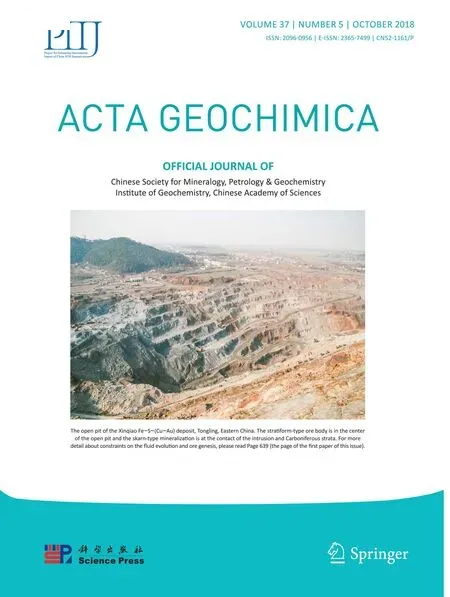Geochemistry of the Palaeo-Mesoproterozoic Tadpatri shales,Cuddapah basin,India:implications on provenance,paleoweathering and paleoredox conditions
2018-10-26··
··
Abstract The Palaeo–Mesoproterozoic Tadapatri formation of the Cuddapah basin is comprised of clastic sedimentary rocks with minor carbonates and mafic–ultramafic sill bodies.Geochemistry of the shale is used to study the provenance,paleoweathering and paleoredox conditions of this Tadpatri formation in order to better understand the development of the Cuddapah basin during Palaeo–Mesoproterozoic time.The higher CIA(average 74.39),PIA(average 85.94)and CIW(average 87.59)values of the Tadpatri shales suggest intensely weathered sources.Higher Al2O3/TiO2(average 30.78)and LREE/HREE ratio(average 8.80)with negative europium anomaly indicate derivation of the clastic sediments from a felsic source rock.The geochemical parameters like U,U/Th,Cu/Zn,Ni/Co,V/Cr ratios reveal that the Tadpatri shales are mainly deposited in an oxic condition.
Keywords Tadpatri⋅Provenance⋅Paleoweathering⋅Paleoredox⋅Geochemistry
1 Introduction
The intracratonic Cuddapah basin of Peninsular Indian Shield is considered as the second largest Purana basin of India(Kale 1991).A sequence of thermal upwarping and rifting with crustal thinning leads to the formation of Cuddapah basin over the Eastern Dharwar Craton(Nagaraja Rao et al.1987;Mishra 2011).However,there is another school of thought that stipulates that the subduction of the oceanic crust in western direction beneath the Dharwar Craton led to the formation of back-arc(extensional)Cuddapah basin at nearly 2000 Ma(Absar et al.2016).Sedimentation within the Cuddapah basin is represented by four different cycles viz.Papaghni cycle,Chitravati cycle,Srisailam cycle,and the Kurnool cycle,which are episodically interrupted by basin-wide unconformities(Saha and Tripathy 2012).The Chitravati cycle is predominantly composed of Pulivendla,Tadpatri and Gandikota formation from base to top.Therefore,the Tadpatri formation is sandwiched between Pulivendla and Gandikota formation and dominantly composed of mixed clasticcarbonate group of rocks with intruded sill bodies at different stratigraphic levels(Nagaraja Rao et al.1987;Patranabis-Deb et al.2012).
The geochemistry of clastic rocks plays an important role in depicting the nature of the provenance,the weathering history of the source area,and the paleooxidation conditions during deposition,which are further used to elucidate the evolution of the ancient depositional basin(Cullers 1995;Cullers and Podkovyrov 2000;Armstrong-Altrin et al.2004,2012;Nagarajan et al.2007;Mir 2015).Among clastic sedimentary rocks,shale is most frequently used to study provenance,paleoweathering,and paleoredox conditions because of its abundance and well homogenization character(Pettijohn 1975;Mir 2015).

Fig.1 Geological maps of the study area a Generalized geological map of the Cuddapah basin(modified after Geological survey of India 1:2 000 000 map,1998);b Geological map of western Cuddapah basin showing the lower Cuddapah group of rocks(after Nagraja Rao et al.1987;Saha and Tripathy 2012);c North-western part of Cuddapah basin showing location of the measured section investigated in this study(modified after Survey of India Quadrangle map number 57E,1981;1:250 000)
Earlier works on the Tadpatri formation essentially focus on the geochemistry of carbonate and mafic–ultramafic rocks,which mainly reflects the depositional environment of Tadpatri stromatolite as well as the depositional age of this formation(Murthy et al.1987;Nagaraja Rao et al.1987;Zachariah et al.1999;Anand et al.2003;French et al.2008;Khelen et al.2017).To date,however,there have been no studies conducted on the Tadptari formation rocks(clastic)to depict its provenance,tectonic setting,source rock weathering and paleoredox condition.Therefore,this work,for the first time,sets its objective to examine the provenance,paleoweathering,and paleoenvironmental set up of Tadpatri formation in order to better understand the development of Cuddapah basin during Palaeo–Mesoproterozoic time.
2 Geological setting
The Cuddapah basin preserves nearly 12 km of Late Palaeoproterozoic to Neoproterozoic sedimentary and volcanic strata which are lithostratigraphically divided into the Cuddapah Supergroup and the Kurnool Group(Saha and Tripathy 2012).The Cuddapah Supergroup is unconformably resting over the Eastern Dharwar Craton,which is essentially composed of Tonalite–Trondhjemite–Granodiorite gneisses,greenstone belts with fewer amounts of mafic dykes(Nagaraja Rao et al.1987).Cuddapah Supergroup consists of Papaghni,Chitravati,Nallamalai Groups and Srisailam formation from base to top(Fig.1a and Table 1;Saha and Tripathy 2012).Each of the group is separated by regional unconformities and composed with clastic as well as non-clastic group of rocks which reflects a gross fining upward succession in a shallow marine shelfal set-up(Patranabis-Deb et al.2012).
The second oldest group within this Cuddapah Supergroup is the Chitravati,mainly exposed in the western part of the basin and consists with Pulivendla,Tadpatri,Gadikota formation from base to top(Fig.1b).Tadpatri formation principally consists with a large variety of shale(siliciclastic,calcareous,ferruginous chert and jasper bearing),limestone and quartzite.Limestone units arethinly laminated to domal and columnar stromatolite bearing(Patranabis-Deb et al.2012).Stromatolites have low amplitutde hemispheroidal forms;smaller laterally linked hemispheroids are also common(Sharma and Shukla 2003).There are also many mafic–ultramafic sill bodies with variable thickness developed at different stratigraphic positions within the Tadpatri formation.The lithology,sedimentary structures and microbialites morphology clearly demonstrate that the deposition of Tadpatri formation is in a shallow marine shelfal condition(Patranabis-Deb et al.2012).
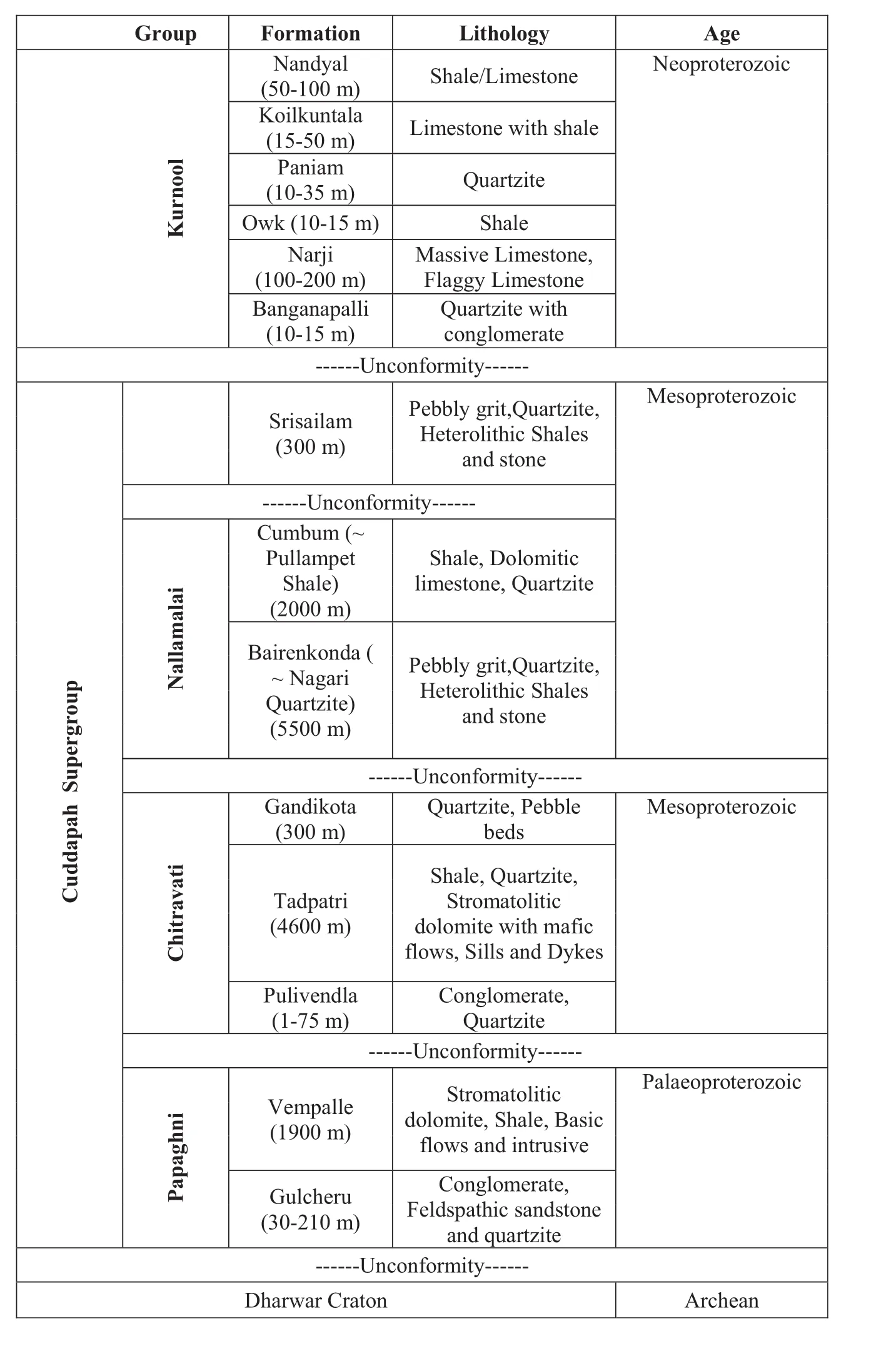
Table 1 Stratigraphy of the Cuddapah Basin(after Nagaraja Rao et al.1987)
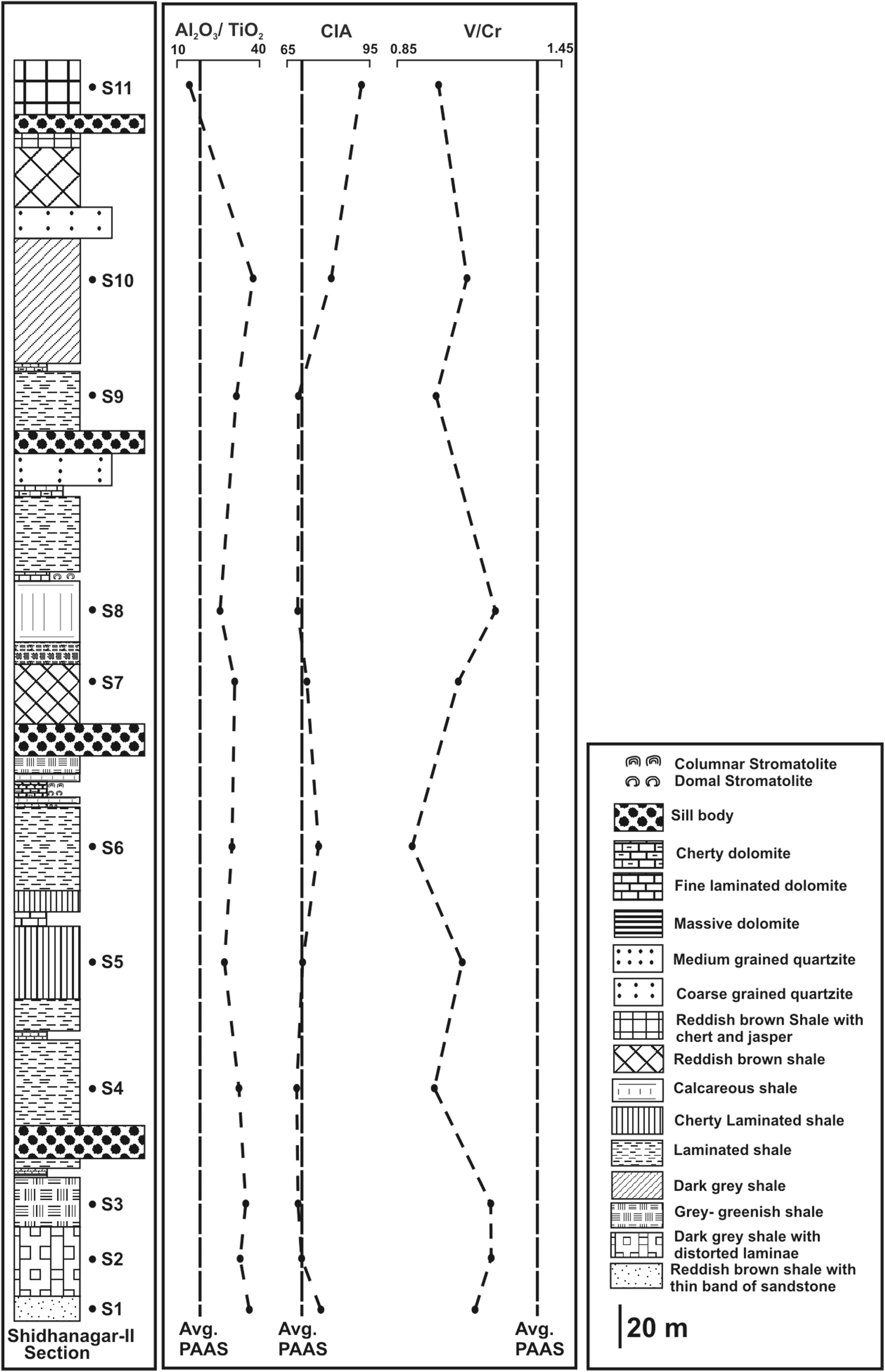
Fig.2 Litholog showing measured stratigraphic section with the positions of the samples collection.Al2O3/TiO2,CIA,V/Cr values of the Tadpatri shales showing their vertical variation alongside with the average PAAS value(Reproduced with permission from Taylor and McLennan 1985)
As the Tadpatri formation is unfossiliferous,its age is mainly reconstructed from the dating of intrusive sill and dykes.40Ar–39Ar dating of phlogopite mica from Tadpatri formation indicates the initiation of volcanism at and around 1900 Ma(Anand et al.2003).206Pb–204Pb dating of Uranium mineralized strata reveals 1756±29 Ma as aminimum age for carbonate sedimentation(Zachariah et al.1999).French et al.(2008)obtained 1885.4±3.1 Ma for a gabbronorite sill body and considered this as the primitive depositional age of the Tadptari formation.K–Ar dating on arc-concentric mafic sills from the top portion of the Tadpatri formation indicates 958±29 and 809±29 Ma as the emplacement age of these sills(Murthy et al.1987).Therefore,based on these previous radiometric datings we can determine that the Tadpatri formation may range between Late Palaeoproterozic to Mesoproterozoic age.
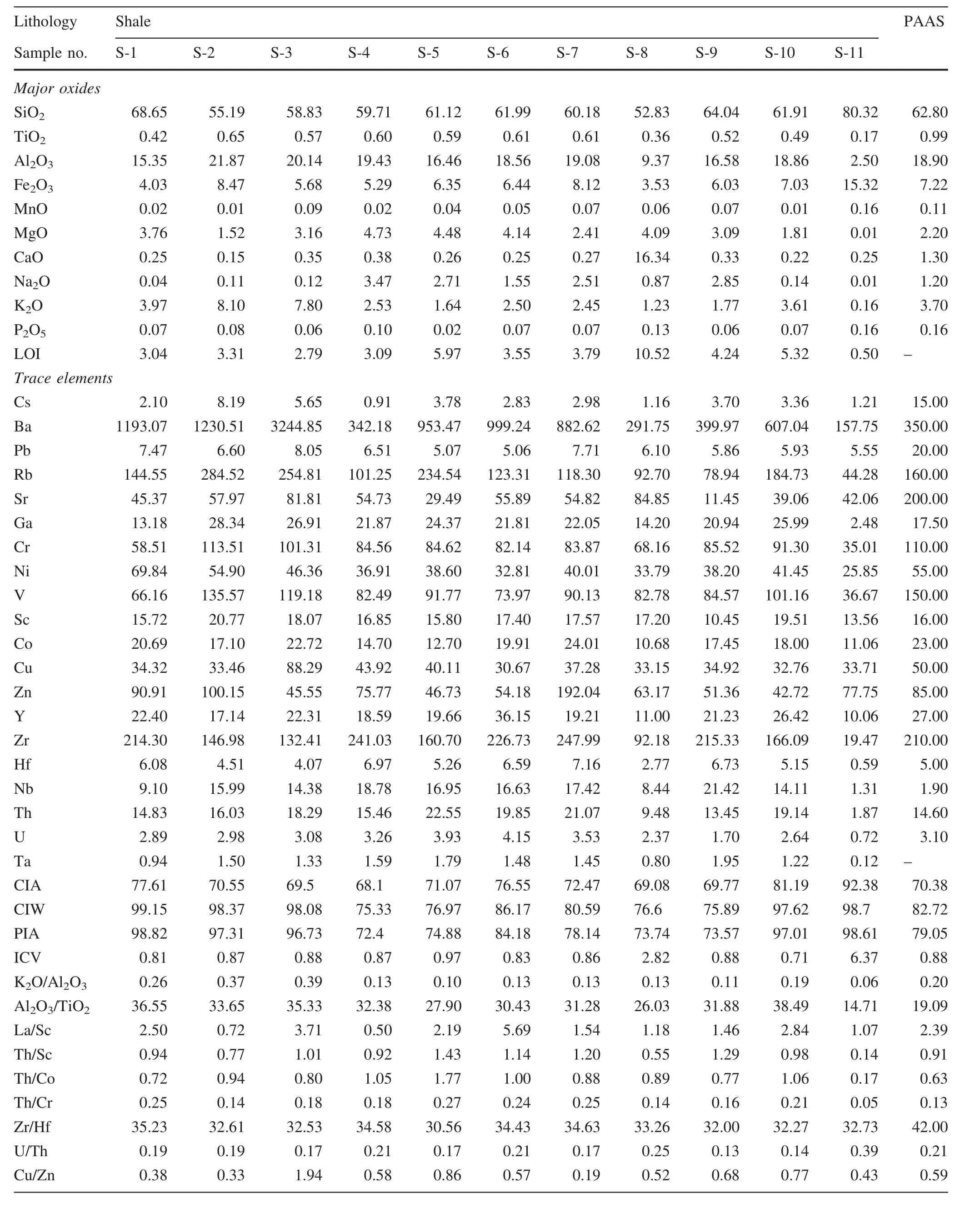
Table 2 Major elements(in wt%)and trace elements(in ppm)concentrations in the Tadpatri shales with average composition of PAAS(Taylor and McLennan 1985)

Table 2 continued
3 Materials and methods
Major element concentrations were obtained by a Bruker model S4 Pioneer sequential wavelength—dispersive X-ray fluorescence(XRF)spectrometer,and the trace and rare earth elements were analyzed by high resolution inductively coupled plasma mass spectrometer(HR-ICPMS)in which GSR-5 was used as the standard.At first,50 mg of each sample was taken in Savillex vessels and 10 mL of 7:3 HF–HNO3acid mixture was added to that sample.The vessels were then tightened and placed on the hot plate at 150°C for 50 h.After that,the vessels were opened and a single drop of HClO4was added to the mixtures,which were further evaporated to near dryness at 160°C.The rest of the residues of each vessel were dissolved by adding 20 mL of 1:1 HNO3–Milli-Q water and placing them on the hot plate for 30–45 min at 100 °C in order to dissolve all suspended particles.Subsequently,Rhodium solution(in an amount 5 mL)was added as an internal standard to each vessel,and the volume was raised to 250 mL by adding Milli-Q water.This solution of each sample was stored in High Density Polyethylene(HDPE)bottles.5 mL of this solution was mixed again with 50 mL Milli-Q water(1:10 ratio)and stored in Eppendorf tubes for analysis.The analytical precision of the geochemical data is better than 5%RSD.
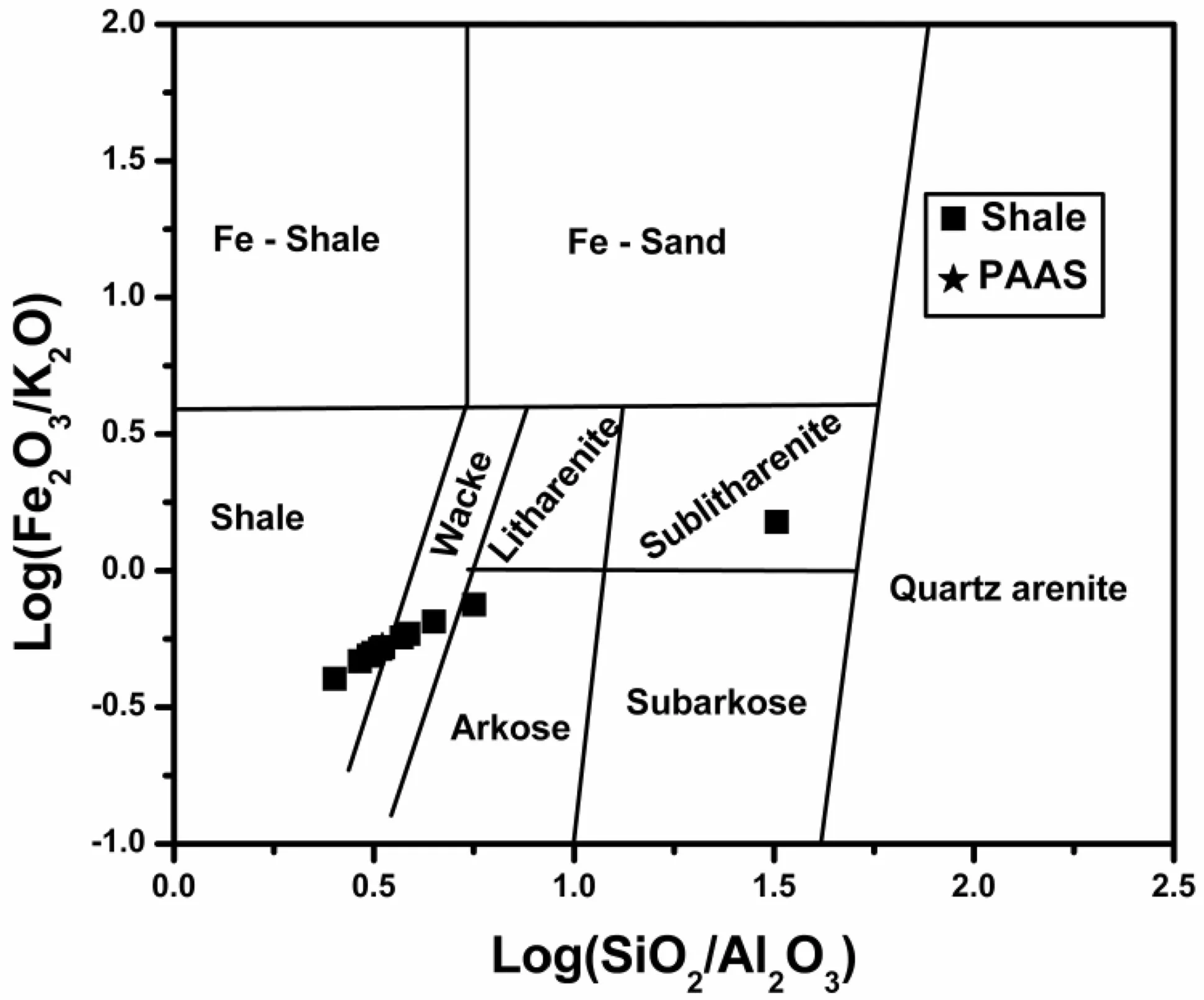
Fig.4 Geochemical classification of Tadpatri shales using the major element composition(Reproduced with permission from Herron 1988)
4 Results
4.1 Petrography

Fig.5 Binary plots of the Tadpatri shales against SiO2
The studied section of the Tadpatri formation is dominated by shale with minor amounts of carbonates and sill bodies(Fig.2).The shales recorded in this section are of different varieties In the basal part,the shale(Sample S-1)is interbedded with a thin band of sandstone.Microscopically this shale(Sample S-1)is dominated by clay minerals and quartz with relatively smaller amounts of ferruginous materials and micas(Fig.3a).This shale type is followed by the dark grey shale with distorted ferruginous laminae(Sample S-2).Under the microscope,sample S-2 is dominated by clay minerals,ferruginous materials and micas with a smaller proportion of quartz when compared to Sample S-1(Fig.3b).The red to dark grey colored ferruginous laminae are moderately to highly distorted.Sample S-3 is massive grey-greenish shale,dominated by clay minerals,muscovite,biotite,quartz and ferruginous materials(Fig.3c).A very small proportion of plagioclase feldspar is also present in sample S-3,but not very persistent throughout all the microscopic studies.Sample S-4 is grey colored laminated shale,dominated by micaceous shale with distinctive thin laminated siltstone(Fig.3d).The contact between the siltstone laminae and shale is sharp and wavy in nature.Individual grains within siltstone laminations are very fine to medium silt sized,subrounded to subangular shaped and moderate to well sorted.Sample S-5 is laminated shale with occasional development of chert band(Fig.3e).Sample S-6 also represents the dark grey colored laminated shale but differs from sample S-4.Sample S-6 is dominated by micaceous to arenaceous shale with relatively thick siltstone laminae(Fig.3f).The contact between the siltstone laminae and shale is sharp and wavy.Individual grains within the siltstone laminations are fine silt sized,subrounded to subangular shaped.Sample S-7 represents the reddish brown ferruginous shale,which is microscopically dominated by clay minerals,ferruginous material,mica minerals and quartz(Fig.3g).The quartz grains are nearly distributed in a uniform way, fine to medium silt sized and rounded to subrounded in shape.Sample S-8 is calcareous shale and found in an association with carbonates.This calcareous shale is dominated by massive,dark grey to black carbonate cemented mud with sparry calcite(Fig.3h).Minor amounts of terrigenous silt are also present.Sample S-9 represents the dark grey laminated shale from the upper part of the studied section.The siltstone laminae are relatively thick and the contact between the siltstone laminae and shale is sharp and straight(Fig.3i).Sample S-10 represents massive dark grey shale,dominated by clay minerals,muscovite,biotite and fine quartz grains(Fig.3j).The mica minerals are showing a preferred orientation.Sample S-11 is the reddish brown ferruginous shale with distinct chert and jasper band and dominate the uppermost part of the studied section.Under microscopic study,alternate banding of siltstone,jasper,and ferruginous shale is prominent with variable thickness(Fig.3k).
4.2 Major elements
Table 2 represents the major oxides data of the shale samples(n=11).Tadpatri shales(except S-8 and S-11)from the study area fall in the field of shale and wacke of the bivariate plot,log(SiO2/Al2O3)versus log(Fe2O3/K2O)(Fig.4;Herron 1988).S-6 sample is overlapped with the average PAAS value(Taylor and McLennan 1985)in this diagram.In comparison with average PAAS value most of the shale samples(except S-8 and S-11)are showing similar SiO2,Al2O3wt%.In contrast,the S-11 sample is depleted in MgO,CaO,K2O and Na2O,which indicates an extreme weathering of the source area or preferably several recycling processes(Chakrabarti et al.2009).Also high weight percentage of Fe2O3in S-11 indicates greater availability of iron compounds in seawater,which is co-sedimented during the rock unit accumulation.This may result from mafic volcanism prior to sedimentation of this shale horizon(Pettijhon 1975).
Bivariate plots of SiO2versus TiO2,Al2O3,MgO,CaO and K2O of the Tadpatri shales exhibit negative correlation(0>r≥-1,n=11)whereas SiO2versus Fe2O3,MnO,and P2O5of these samples display positive correlation(0<r≤1,n=11)(Fig.5).However,TiO2,MgO and K2O display positive correlation(0<r≤1,n=11)with Al2O3(Fig.6).This implies that the distribution of K2O,TiO2and MgO within the rock is possibly controlled by Al2O3.SiO2versus Na2O bivariate plot reflects two trends(horizontal and positive)(Fig.5)between Si–Na.A similar consideration is also observed between Al–Na(Al2O3versus Na2O plot;Fig.6).
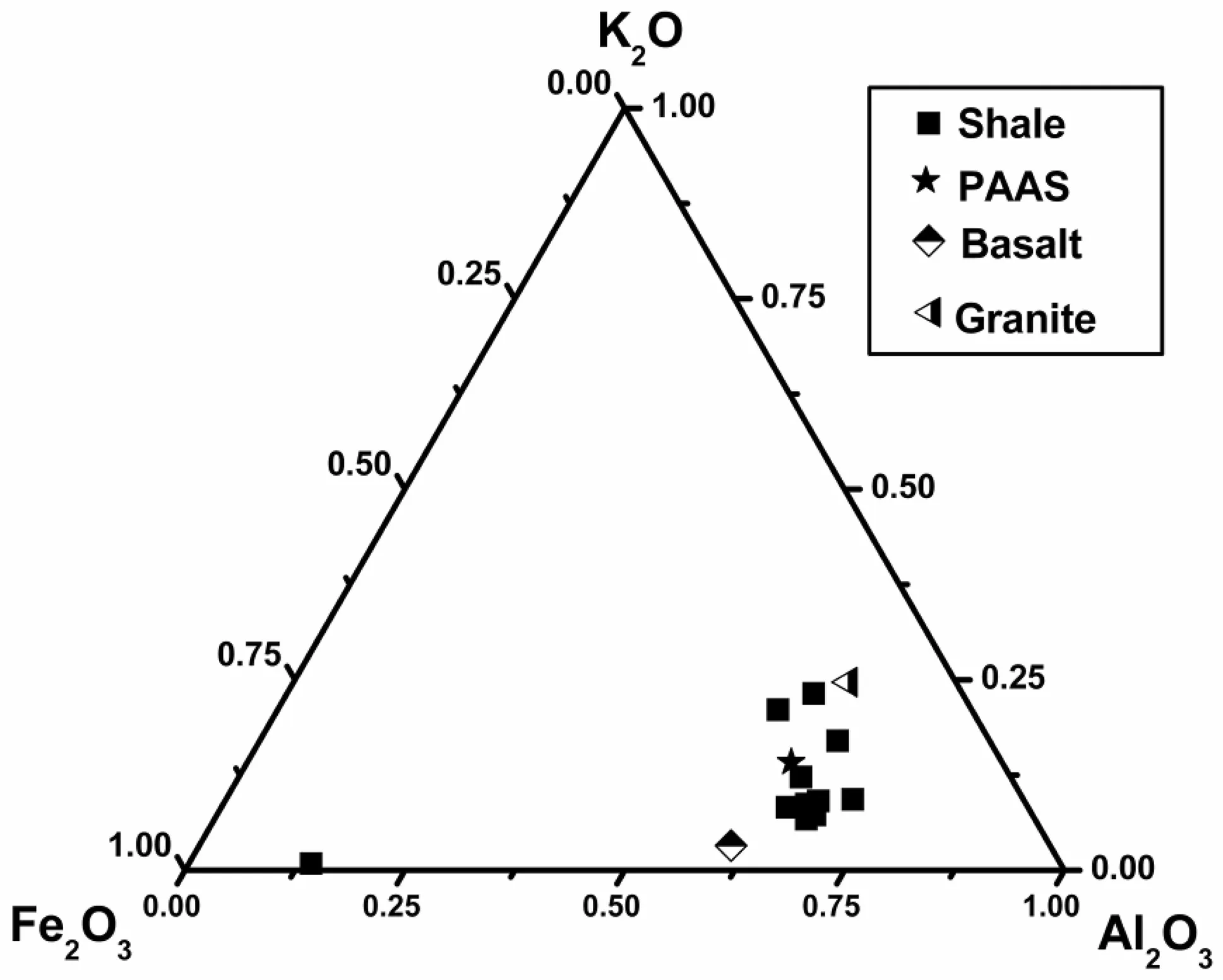
Fig.7 Major element distribution in the Tadpatri shales in Fe2O3–K2O–Al2O3compositional space.The data on granite,basalt and PAAS are defined from Condie(1993)and Taylor and McLennan(1985)respectively
The ternary diagram of Fe2O3–K2O–Al2O3(Fig.7)shows that most of the shale samples(except S-11)are plotted near Al2O3apex.This indicates their enrichment in Al2O3,which further implies that the element abundances are predominantly controlled by clay minerals(Wronkiewicz and Condie 1987).The K2O/Al2O3ratio of sediment is used as the index of initial composition of ancient sediments;for example,for clay minerals and feldspars it is 0.0–0.3 and 0.3–0.9,respectively(Cox et al.1995).For the Tadpatri shale samples the K2O/Al2O3ratio shows a variation from 0.06 to 0.39 with an average of 0.18(Table 2).As the K2O/Al2O3ratio in some shale samples is near the upper limit of clay mineral,illite is considered to be the dominant clay mineral(Chakrabarti et al.2009).
4.3 Trace elements
Table 2 also represents the trace elements data with the elemental ratios of the shale samples.PAAS normalized trace elements are plotted in a multielement diagram,which shows depletion of Cs,Pb,Sr,Cr,Ni,V,Co and moderate to slight enrichment of Nb,Th,and U(Fig.8a).
As incest has become a more open topic and acknowledged in modern society, Donkeyskin has become less popular as an uncomfortable story for adults to share with children. Return to place in story.
Within high field strength elements(HFSE)the element pairs Hf–Zr and Ta–Na are very much identical in size and charge;therefore they show similar geochemical behavior.In the Tadpatri shale samples,Zr has a very strong correlation(r=0.99,n=11)with Hf,while Nb has a very strong correlation(r=0.98,n=11)with Ta(Table 3).This indicates their similarity in geochemical behavior and also implies that they are not differentiated during the weathering process(Long et al.2012;Armstrong-Altrin et al.2017).All the HFSEs of the Tadpatri shales show good positive correlations between them and also have a positive correlation with TiO2(Table 3).
Sr values within the shale samples vary from 11.45 to 84.85 ppm with an average 50.68 ppm.Sr has no effective positive correlation with Al2O3and K2O,whereas it is positively correlated (moderate, r=0.54, n=11;Table 3)with CaO,indicating their affinity to Ca.The concentration of Ba ranges between 157.75 and 3244.85 ppm,which is positively correlated with K2O(r=0.78,n=11;Table 3).This barium concentration can be treated as a proxy of detrital flux.Tadpatri shale samples are showing overall enrichment in Barium,and this is may be due to their deposition in a shallow marine condition(Nagarajan et al.2007).Within these trace elements,Cs,Rb,Cr,V,Sc,and Co are showing positive correlation with Al2O3and K2O(Table 3).This implies that these elements are mainly concentrated within the clay mineral and are accumulated during weathering process(Fedo et al.1996;Armstrong-Altrin et al.2015a,b).
4.4 Rare earth elements
Table 4 represents the rare earth elements(REE)data of the shale samples.The concentration ofΣREE within the Tadpatri shales varies from 51.56 to 406.92 ppm.The bulk REE are generally bounded within the fine clastic with the understanding that trivalent REE are easily settled in clay mineral,which is typically enriched in alumina and ferric iron(Nagarajan et al.2007;Ramos-Vázquez et al.2017).The chondrite normalized REE plot(Fig.8b)of this Tadpatri shale show moderately inclined LREE(La–Eu section)and nearly flat HREE(Gd–Lu section)patterns with negative Eu anomaly(Fig.8b).Eu/Eu*values of all the Tadpatri shale samples are within 0.50 and 0.80(<0.85,Table 4),which indicate their recycling from upper continental crust(UCC).The negative Eu anomaly with 1.54 average value of Gdn/Ybnratio is also a distinctive feature of Tadpatri shales,which indicates their deposition in Post Archean timescale(Taylor and McLennan 1985).
5 Discussion
5.1 Paleoweathering
Numerous geochemical parameters are frequently used to determine the weathering intensity of source rock.Within these parameters,the Chemical Index of Alteration(CIA)and A–CN–K diagram are the most important(Manikyamba et al.2008;Nagarajan et al.2014).CIA is considered as the ratio of primary mineral and clay mineral and is formulated as [Al2O3/(Al2O3+CaO*+K2-O+Na2O)]×100(Nesbitt and Young 1982,1984).The value is expressed in molar proportion,and CaO*represents CaO present in silicate mineral,following McLennan(1993).In unweathered igneous rock the CIA value is around 50,and for intensely weathered rock(mainly composed of kaolinite,gibbsite),the value is near 100(Nesbitt and Young 1984).The CIA computed for Tadpatri shale samples have values ranging from 68.10 to 92.38 with an average 74.39(Table 2),which is comparatively high and indicates high weathering of the source rock.A comparative study of CIA between shale samples and PAAS shows more or less a similar weathering intensity of the source rocks(Fig.2).The K2O/Al2O3ratio(average 0.18)of the Tadpatri shales indicates the presence of illite clay,which further suggests that the sediment is mainly derived in a cold climatic condition(Chakrabarti et al.2009).In Al2O3–(Cao*+Na2O)–K2O (A–CN–K)diagram(Fig.9)the direction of ideal weathering is parallel to A–CN side,and as the weathering continues,the direction advanced near to the illite composition(Fedo et al.1995).In this diagram,some Tadpatri shales are plotted close to the Al2O3–K2O line,which indicates intense weathering of the source rock(Hessler and Lowe
2006).The CIA value may be decreased due to K-metasomatism and therefore the Plagioclase Index of Alteration(PIA)and Chemical Index of Weathering(CIW)values are considered to better estimate the weathering of source rock.PIA and CIW are formulated as[(Al2O3-K2O)/(Al2-O3+CaO*-K2O+Na2O)]×100 and [Al2O3/(Al2-O3+CaO*+Na2O)]×100,respectively(Fedo et al.1995;Harnois 1988).Higher average values of PIA and CIW(85.94 and 87.59 respectively,Table 2)of Tadpatri shales also indicate that the source rock has suffered intense weathering.
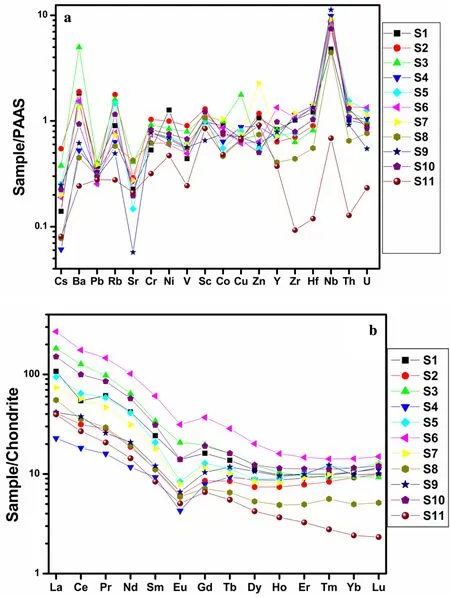
Fig.8 Distribution of a PAAS-normalized trace elements and b Chondrite normalized REE elements in Tadpatri shales.PAAS and Chondrite normalized values are defined from Taylor and McLennan(1985)
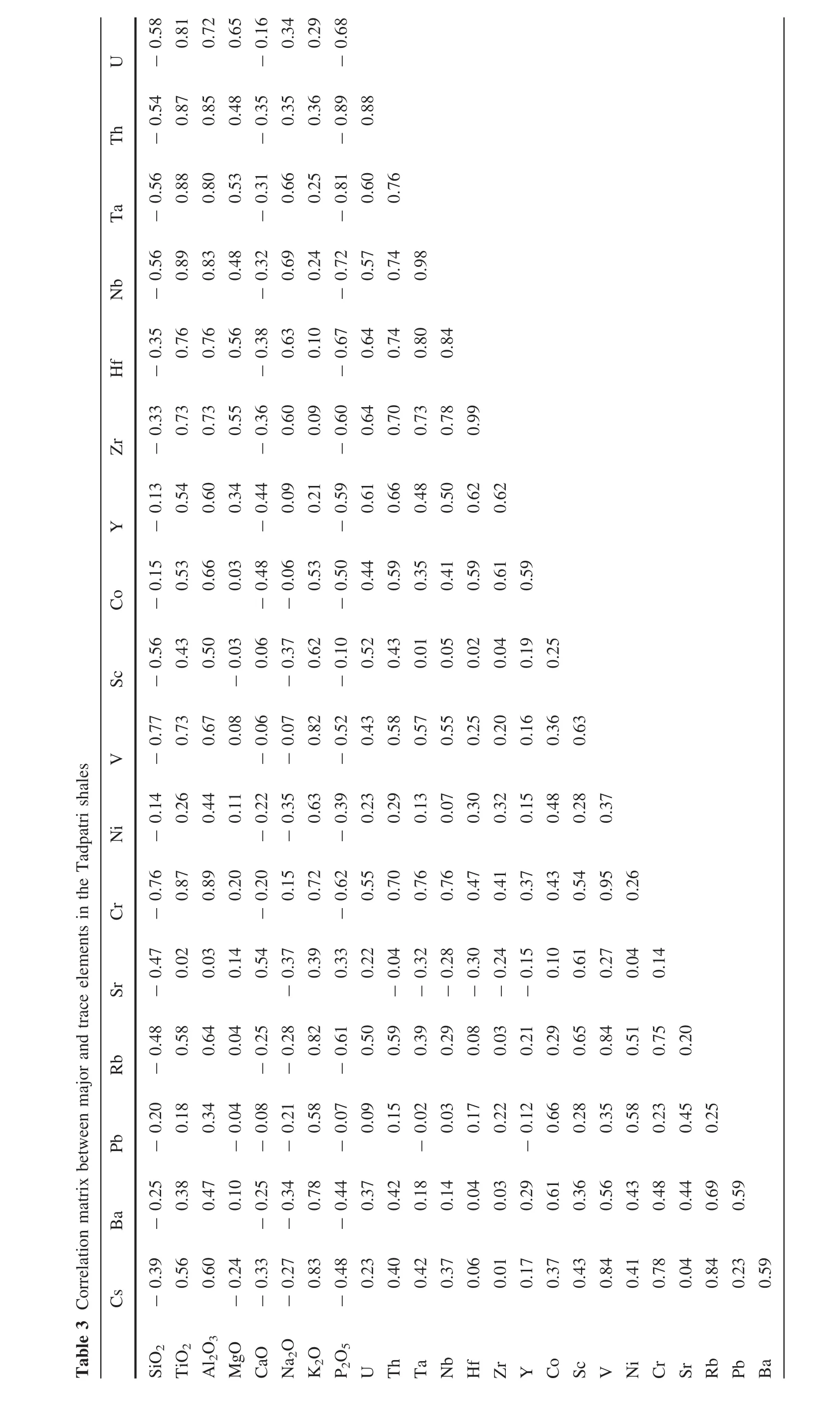
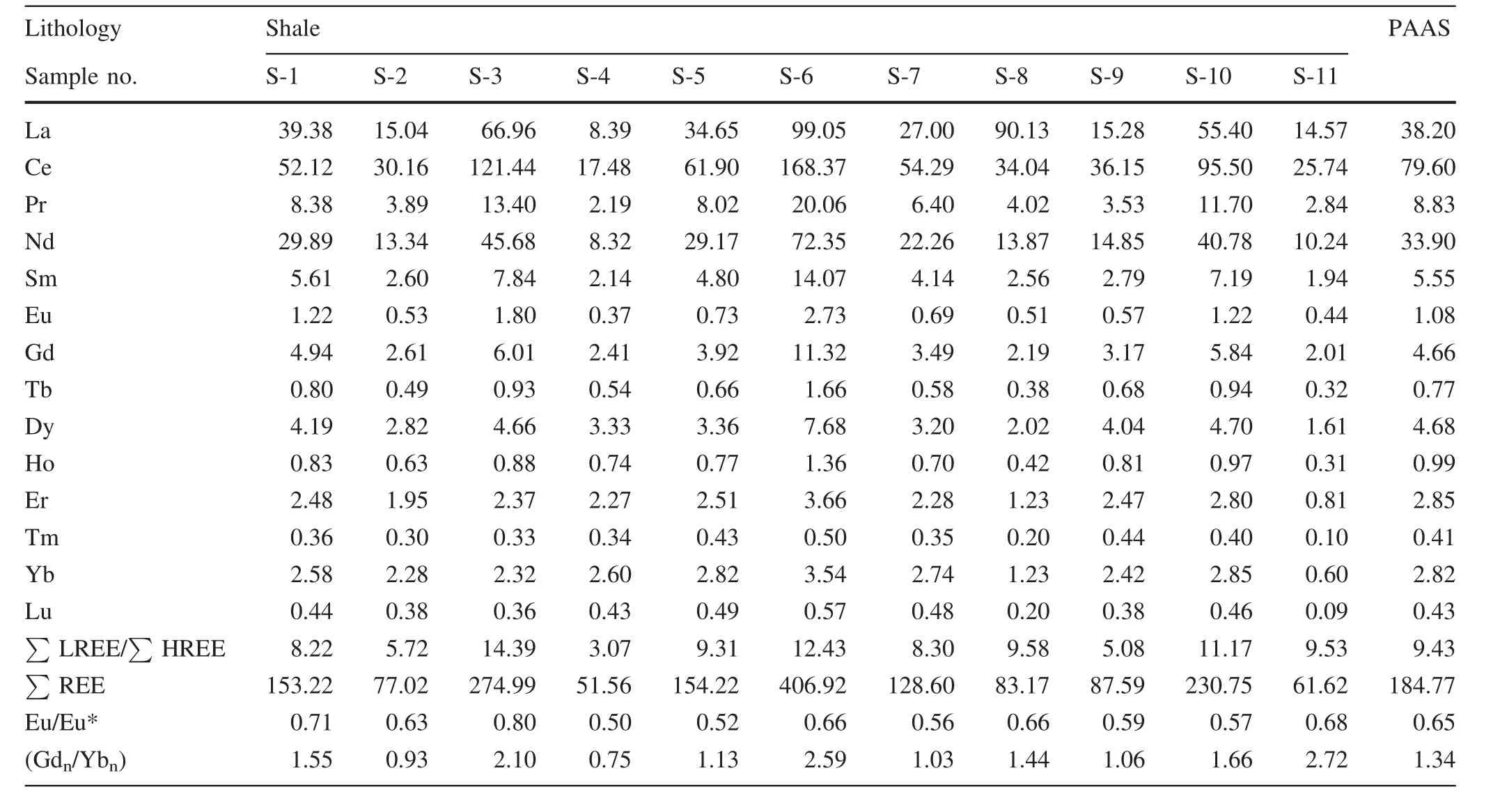
Table 4 REE(in ppm)concentrations in the Tadpatri shales with average composition of PAAS(Taylor and McLennan 1985)
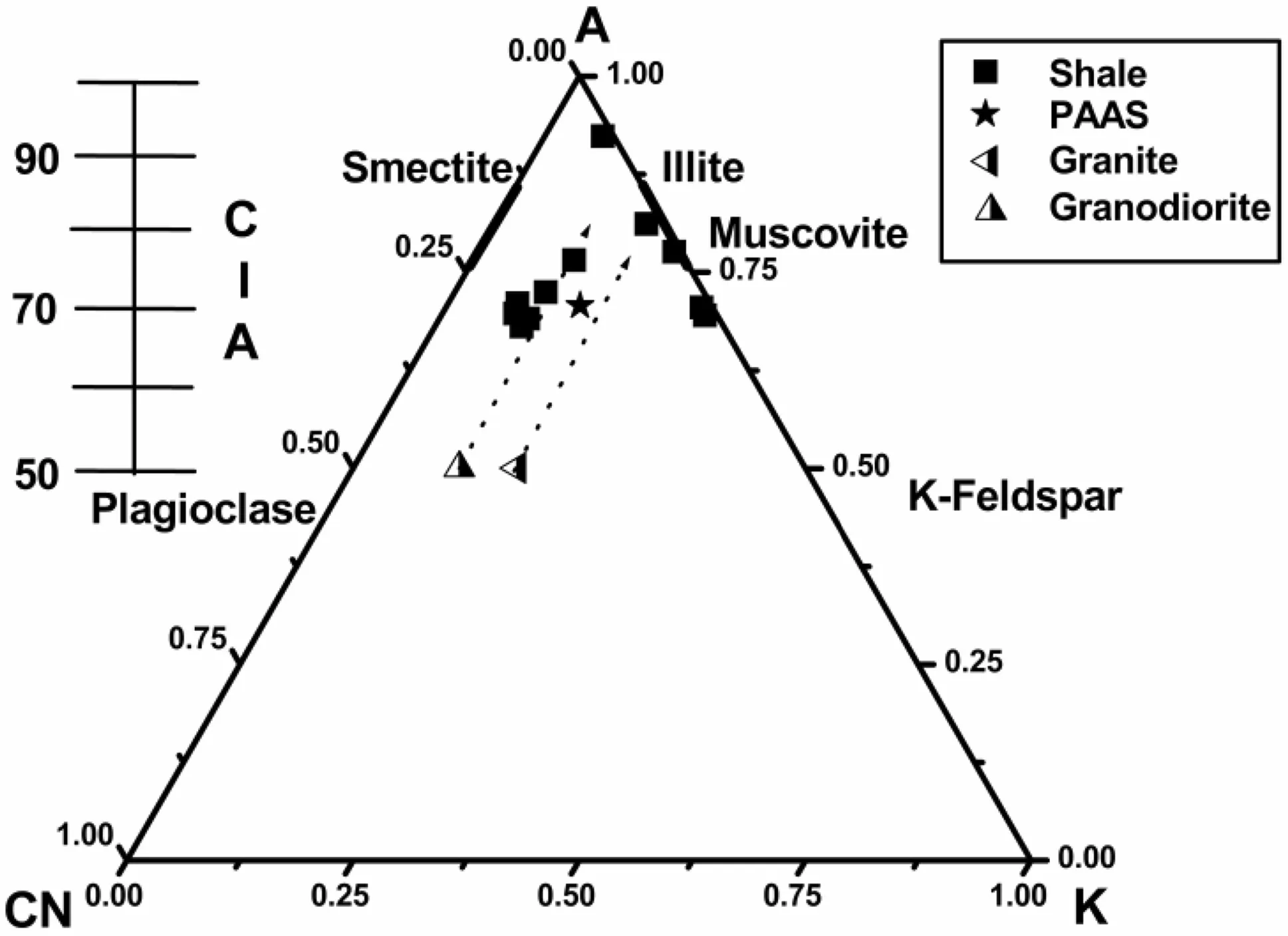
Fig.9 Molecular proportions of A-CN-K diagram for the shales of Tadpatri formation,after Nesbitt and Young(1984).The dashed arrows represent weathering trend of Granite and Granodiorite(Reproduced with permission from Nesbitt and Young 1984)
The Index of Compositional variability(ICV)also indicates the original composition of fine clastic rock and is formulated as(Fe2O3+K2O+Na2O+CaO+MgO+TiO2)/Al2O3.Compared to the clay minerals,non-clayey minerals(pyroxene,feldspar)show higher ICV values(>1)(Cullers and Podkovyrov 2000).Therefore,shale with high ICV values indicates the presence of higher amounts of nonclayey minerals and is considered to be immature(Cox et al.1995).All of the Tadpatri shales except S-8 and S-11 have ICV value less than 1 and therefore are considered to be mature(Table 2).Sample S-8 and S-11 have ICV values that are greater than 1 mainly due to their enrichment in carbonate(CaO)and ferruginous(Fe2O3)component,respectively.
5.2 Provenance
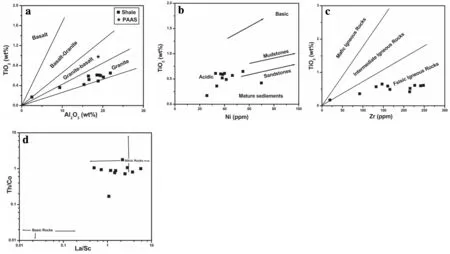
Fig.10 Scatter plots of a Al2O3versus TiO2;b Ni versus TiO2;c Zr versus TiO2and d La/Sc versus Th/Co indicate the derivation of Tadpatri shales from felsic source rocks

Table 5 Range of elemental ratios of Tadpatri shales compared to the ratios derived from felsic rocks(Cullers 2000),mafic rocks(Cullers 2000),upper continental crust(Taylor and McLennan 1985)and PAAS(Taylor and McLennan 1985)
The geochemical characteristics of shale have been widely used to depict the provenance nature(Cullers 2000;Armstrong-Altrin et al.2004;Sun et al.2013).Al2O3/TiO2ratio distinctly varies from mafic(3–8)to intermediate(8–21)as well as in felsic rocks(21–70)(Hayashi et al.1997).Therefore Al2O3/TiO2ratio of the sediments,derived from those igneous rocks can be used as a proxy of source rock composition(Armstrong-Altrin 2009).In Tadpatri shale samples,Al2O3/TiO2varies between 26.03 and 38.49(excluding S-11 sample with 14.70 Al2O3/TiO2)with the average of 30.78(Table 2).This suggests that felsic granitoid to granite rocks are the probable source rocks.A comparative study of Al2O3/TiO2between Tadpatri shales and PAAS shows that Tadpatri shales derived from a more felsic source rock(Fig.2).Plotting of the Tadpatri shale samples in the binary diagram Al2O3versus TiO2(Amajor 1987)(Fig.10a)demonstrates that except for S-11,all the shales are in the field of granite,which indicates their derivation from a felsic source rock.Ni versus TiO2bivariate plot(Fig.10b;Floyd et al.1989),Zr versus TiO2bivariate plot(Fig.10c;Hayashi et al.1997)and La/Sc versus Th/Co plot(Fig.10d;Cullers 2002)also demonstrates the derivation of Tadpatri shales from a felsic rock.
Table 5 represents a range of trace element ratios(Th/Sc,Th/Co,Th/Cr,La/Co,La/Sc)of the Tadpatri shales.Trace elemental ratios of the clastics derived from felsic and mafic rocks are also given in Table 5,which shows a distinct separation in their ranges(Cullers 2000).Comparison of these elemental ratios with the Tadpatri shales’elemental ratio clearly demonstrates that the Tadpatri sediments derived from felsic rock.
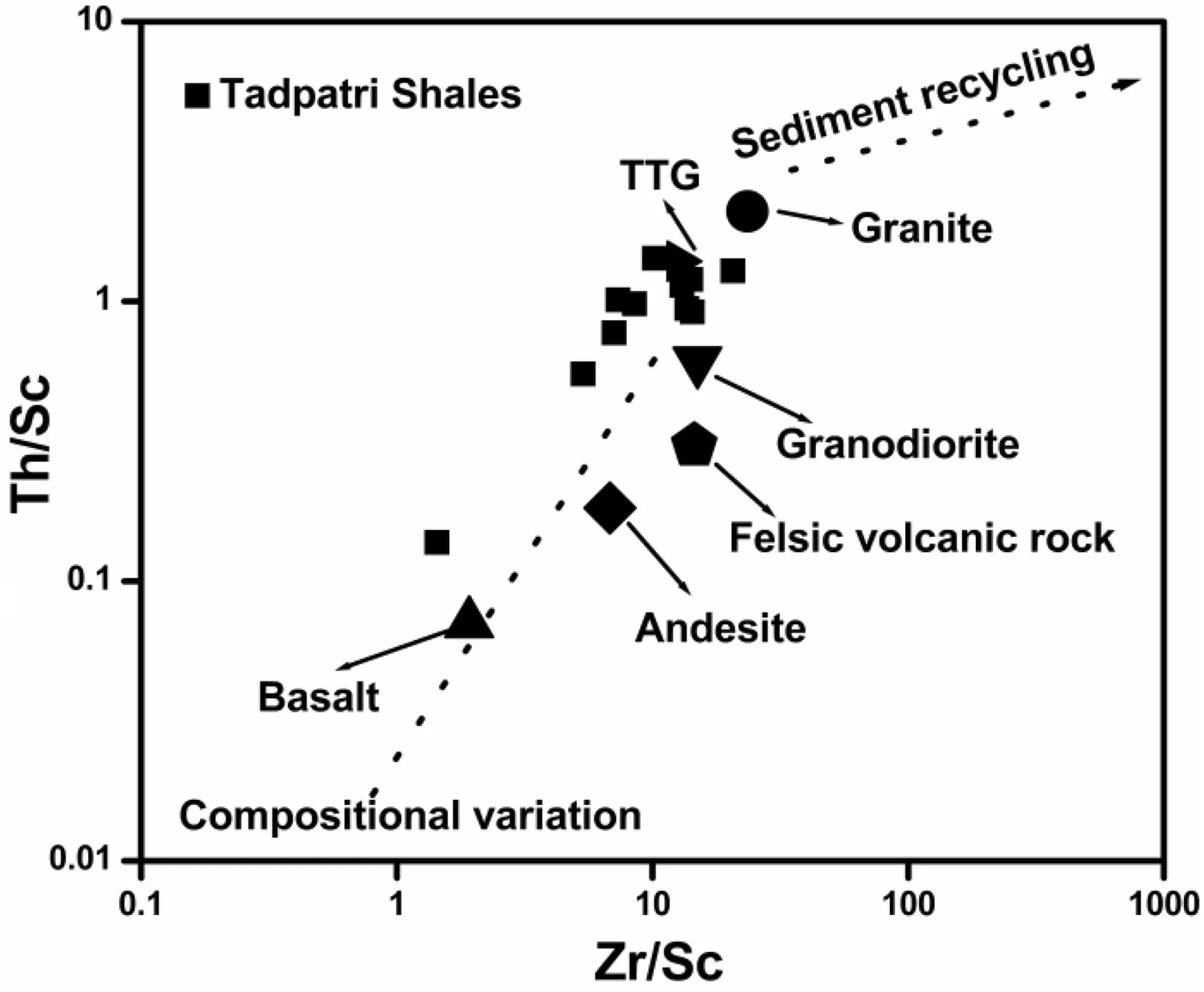
Fig.11 Plot of Zr/Sc versus Th/Sc(after McLennan et al.1993)regarding sedimentary sorting and provenance.The data on average rock compositions(granite,TTG,granodiorite,felsic volcanic rock,andesite,basalt)are defined from Condie(1993)
Not only major and trace elements,but also REE with Eu anomaly plays a key role in depicting the source rock characteristic(Tapia-Fernandez et al.2017).Higher LREE/HREE ratio with a negative Eu anomaly indicates derivation from felsic rock and the lower LREE/HREE with no or a small Eu anomaly implies derivation from mafic rock(Cullers 1995).As the Tadpatri shales show high LREE/HREE ratios(average 8.80)(Table 4)with negative Eu anomaly,they also indicate their derivation from felsic source rock.
As Zr,Th,Sc are immobile and insoluble in nature,the plotting of Zr/Sc versus Th/Sc(Fig.11)is applied to determine the sorting of zircon(McLennan et al.1993;Spalletti et al.2008).Tadpatri shale samples from this study area show a positive slope in the diagram.Most of the Tadpatri shales exhibit Zr/Sc and Th/Sc values near 10 and 1,respectively.According to this diagram,the zircon in the most shale samples is not winnowed during the sedimentary process.This observation is also supported by the average Zr/Hf ratio of the shale samples(33.17;Table 2),which is very much similar to the Zr/Hf ratio(33,Taylor and McLennan 1985)of UCC.A felsic source rock for the Tadpatri shales is also supported by this Zr/Sc versus Th/Sc diagram(Fig.11)as most of the shales are well plotted within the field of granodiorite–TTG–granite.
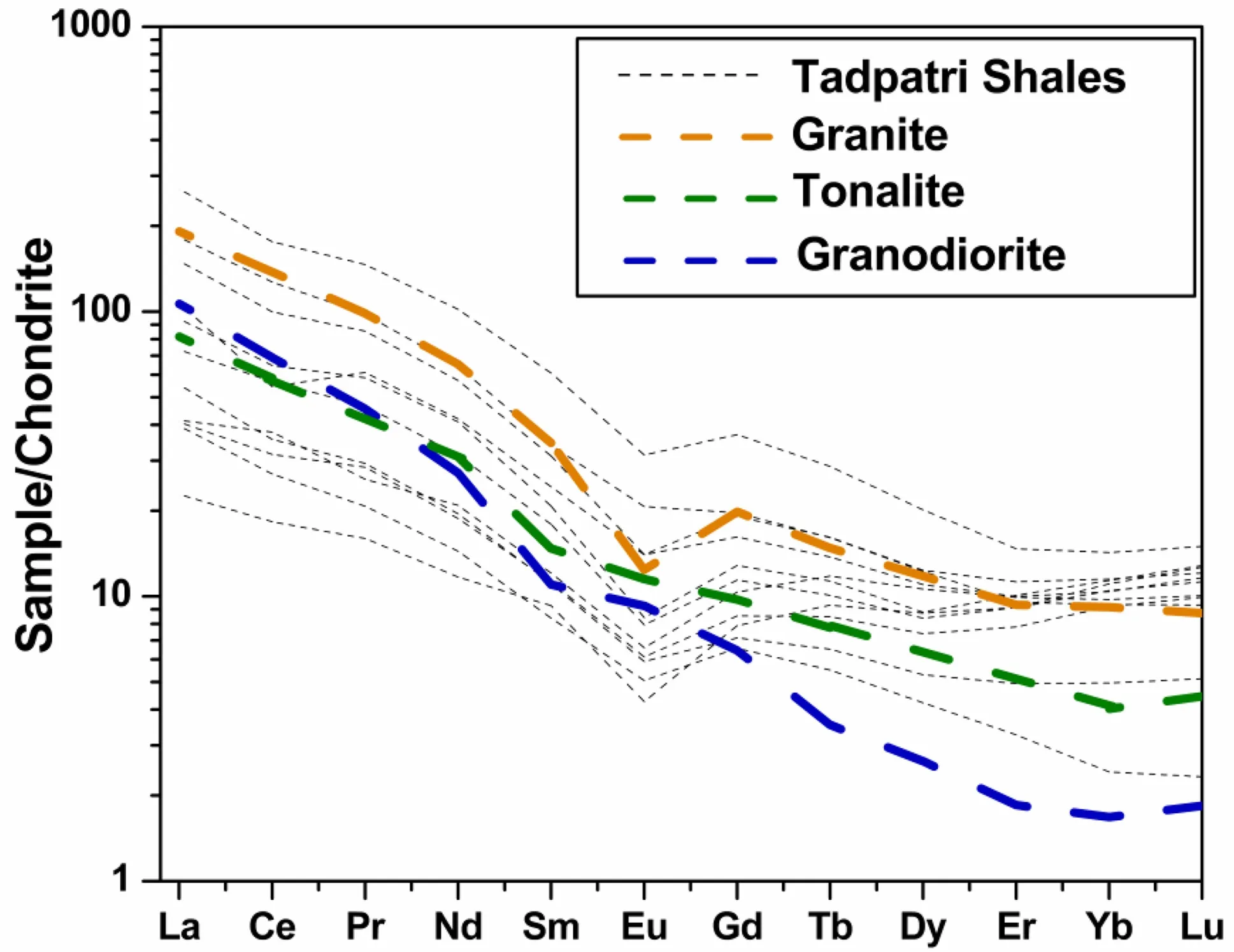
Fig.12 Chondrite-normalized REE patterns of three potential source rocks(granite,tonalite,granodiorite)of Eastern Dharwar Craton with the Tadpatri shales
As the lower Cuddapah Group of rocks developed over the Eastern Dharwar Craton,granite,granodiorite and tonalite of the Eastern Dharwar Craton are likely to be considered as the source rocks of the Tadpatri shales.For the source rock compilation we are following the methodology used in Armstrong-Altrin(2009).Based on that,the chondrite-normalized REE pattern of the Tadpatri shales is compared with the chondrite-normalized REE pattern of granite,granodiorite(Jayananda et al.2000)and tonalite(Allen 1985)of the Eastern Dharwar Craton(Fig.12)which clearly shows the derivation of the Tadpatri shales from a mixing of source rocks like granite,granodiorite, tonalite.The Eu/Eu*ratio of most of the shales is within the range of Tonalite(Eu/Eu*=0.96,Allen 1985)and Granite(Eu/Eu*=0.48,Jayananda et al.2000).Therefore it can be presumed that granite and tonalite are the most dominant source rocks of the Tadpatri shales.This comparative chondrite-normalized REE diagram(Fig.12)distinctly suggests that seven numbers of Tadpatri shales follow the trend of granite,3 numbers of Tadpatri shales follow the trend of tonalite and a single sample follows the trend of granodiorite.Therefore we can argue that the Tadpatri shales are most likely derived from a felsic rock,which is a mixing of granite(65%),tonalite(25%)and granodiorite(10%)from the Eastern Dharwar Craton.
Major oxides data are applied for tectonic discrimination based plots(Bhatia 1983;Roser and Korsch 1986;Verma and Armstrong-Altrin 2013;Armstorng-Altrin 2015).Here we are considering the new discrimination diagrams proposed by Verma and Armstrong-Altrin(2013);Armstorng-Altrin(2015)as the success rate of these diagrams are relatively higher(75%–100%success rate)compared to the old discrimination diagrams proposed by Bhatia(1983)and Roser and Korsch(1986).The new tectonic diagrams(Verma and Armstrong-Altrin 2013)are applied to discriminate three major tectonic settings—arc,rift,and collision settings.Based on these diagrams the Tadpatri shales are grouped into high silica(SiO2(adj)>63%–≤ 95%;sample S-1,S-5,S-6,S-9,S-10,S-11)and low silica(SiO2(adj)>35%–≤ 63%;sample S-2,S-3,S-4,S-7,S-8)rocks and most of them(except sample S-11)are well plotted within arc and collision fields(Fig.13a,b).There is an indiscrimination in the use of the discrimination diagram,exclusively in which major oxides data are used for provenance study(Armstrong-Altrin and Verma 2005;Verma and Armstrong-Altrin 2013,2016).In this respect,immobile trace elements(La,Th,Sc,Zr)are more reliably applied to study the tectonic setting(Mir 2015;Li et al.2017).Ternary diagrams(Bhatia and Crook 1986)applied for tectonic discrimination also have some issues.In the La–Th–Sc ternary plot,the active and passive margins are marked by a single compositional field,and the success rate lies between 0%and 0.6%(Verma and Armstrong-Altrin 2016).Here we are considering only the Th–Sc–Zr/10 diagram(Fig.13c)whose success rate is within 0%–9.3%(Verma and Armstrong-Altrin 2016).In this diagram,except for sample S-11,all the Tadpatri shales are well plotted within the field of the continental arc.

Fig.13 Tectonic discrimination diagrams for Tadpatri shales a Fields are demarcated after Verma and Armstrong-Altrin(2013),the subscript m1 in DF1 and DF2 represents the high silica(SiO2(adj)>63%–≤ 95%)diagram based on logeratios of major elements,SiO2(adj)is the SiO2 value calculated after volatile free adjustment of the ten major elements to 100 wt%,SiO2(adj)value of sample S-1,S-5,S-6,S-9,S-10,S-11 is 71.10,65.25,64.47,67.17,65.76,81.08 respectively;b Fields are demarcated after Verma and Armstrong-Altrin(2013),the subscript m2 in DF1 and DF2 represents the low silica(SiO2(adj)>35%–≤ 63%)diagram based on logeratios of major elements,SiO2(adj)value of sample S-2,S-3,S-4,S-7,S-8 is 57.40,60.77,62.03,62.84,59.49 respectively;c Th–Sc–Zr/10 fields are demarcated after Bhatia and Crook(1986)

Fig.14 Paleoenvironment of Tadpatri shales.a Binary plot of SiO2versus(Al2O3+Na2O+K2O)indicates deposition is in mainly semiarid climate;b Binary plot of Ni/Co versus V/Cr indicates oxic condition during deposition and c Binary plot of Ni/Co versus V/(V+Ni)indicates oxic to anoxic condition during deposition
There are several previous works that focused on basin evolution and tectonism of the Cuddapah basin.Based on fault pattern(transfer faults)and kinematic history,Chetty(2011)proposed that the development of Cuddapah basin is
genetically related with Proterozoic collisional process.Sesha Sai et al.(2017)also suggest a continental arc setting during the evolution of the lower Cuddapah Group of rocks(Papaghini and Chitravati Group).Therefore the finding concluded from analyzing the above discussed tectonic discriminant diagrams is very much similar with the previous works.
5.3 Paleoredox conditions
The bivariate plot,SiO2versus(Al2O3+Na2O+K2O)(Fig.14a;Suttner and Dutta 1986)is applied to depict the climatic situation during Tadpatri clastic sedimentation.Most of the Tadpatri shale samples(except S-11)are well fitted in the area of semiarid climate,suggesting their deposition principally in semiarid condition.
Trace elements like U,Th,Cu,Zn,Ni,Co,V,Cr play a crucial role in interpreting the paleoredox condition.Sediment deposited in oxidizing environment mostly has a low content of U,whereas those are deposited in oxygen minimum zone(OMZ)reflect higher content of U(Somayajulu et al.1994;Madhavaraju and Ramasamy 1999;Armstrong-Altrin et al.2015a;Ramos-Vázquez et al.2017).Therefore the low U content(average 2.84 ppm)of the Tadpatri shale samples suggest that deposition of the Tadpatri formation is in an oxygenated condition.A U/Th ratio lower than 1.25 suggests oxidizing depositional condition and a value greater than 1.25 indicates deposition in a suboxic to anoxic environment(Nath et al.1997).As the U/Th ratio of the Tadpatri shale samples(0.13–0.39 with an average 0.20;Table 2)is less than 1.25,it also indicates the deposition of clastic sediments in an oxic condition.A Cu/Zn ratio with a higher value indicates sediment deposition in a reducing environment,whereas the lower value supports an oxic environment(Nagarajan et al.2007).In Tadpatri shale samples,the Cu/Zn ratio ranges between 0.19 and 1.94,with the average value of 0.66(Table 2),which reveals a dominantly oxic condition during deposition,whereas a wide variation(low to moderate)in Cu/Zn ratio implies a fluctuating oxic condition(Oxic to slightly sub-oxic),possibly as a result of sea level shifting in Post-Archean period(Mir 2015).A Ni/Co ratio is also used to infer the depositional condition.All the analyzed samples have less than 5 Ni/Co ratios(average 2.22;Table 2),which indicates an oxic condition during deposition.Vanadium is commonly associated with the sediment as those are deposited in reducing condition,whereas Cr association within the sediment is not effected by redox condition(Dill 1986;Mir 2015).Therefore a V/Cr ratio greater than 4.25,within 2.00–4.25 and less than 2.00 indicates suboxic to anoxic,dyoxic and oxic environments,respectively(Jones and Manning 1994).Also,a V/(V+Ni)ratio higher than 0.84 suggests an euxinic condition,0.54–0.82 represents an anoxic condition and 0.46–0.60 represents a dysoxic condition(Rimmer 2004;Mir 2015).A comparative study of V/Cr in between Tadpatri shale samples and PAAS showing relatively lesser values of the Tadpatri shale samples and implies oxic depositional environment(Fig.2).Therefore based on this study it can said that the Ni/Co and V/Cr ratios(Fig.14b)of Tadpatri shales suggests an oxic condition whereas the Ni/Co and V/(V+Ni)ratios(Fig.14c)indicates that deposition is in an oxic to anoxic condition.
6 Conclusions
The geochemical signatures of clastic sedimentary rocks from Palaeo-Mesoproterozoic Tadptari formation provide important information about provenance,degree of paleoweathering and paleoredox condtions.
The CIA,PIA,CIW ratios of the Tadpatri shale samples indicate intense chemical weathering of the source rock.Based on chemical composition of Al2O3,K2O and Na2O illite is considered as most common clay mineral within the Tadpatri shales.
The Al2O3/TiO2ratio,the REE pattern,the trace elemental ratio(La/Sc,Th/Sc,Th/Co,La/Co),and the La/Sc versus Th/Co,Ni versus TiO2,Zr versus TiO2plot reveal that the Tadpatri shales are principally derived from felsic source rocks.A mixed rock of 65%granite,25%tonalite and 10%granodiorite of Eastern Dharwar Craton is proposed as the source rock of Tadpatri shales.
The trace-elemental signatures(U,U/Th,Ni/Co,V/Cr)imply the deposition of Tadpatri formation in an oxic environment.The wide range of Cu/Zn ratios of the Tadpatri shales implies that depositional environment fluctuates between oxidizing to sub-oxidizing conditions,possibly as a result of sea level change in Post-Archean period.
AcknowledgementsThe authors are grateful to the Department of Science and Technology(DST),Government of India for financial support vide PURSE(Phase-II)program(No.F4/SC/20/15)and University Grants Commission(UGC),New Delhi for the scholarship of the first author.Analyses of the major oxides and Trace,REE are performed at National Centre for Earth Science Studies,Thiruvananthapuram,Kerala and National Geophysical Research Institute,Hyderabad respectively.The authors are thankful to the Directors of these institutions. The authors are also grateful to Dr.C.Manikyamba,Senior Principal Scientist,NGRI and Dr.Sisir Mondal,Professor,Jadavpur University for their whole hearted support.Sincere thanks are also being accorded to Dr.J.S.Armstrong-Altrin and an anonymous reviewer for their constructive comments.
杂志排行
Acta Geochimica的其它文章
- Lithium elemental and isotopic disequilibrium in minerals from peridotite xenoliths from Shangzhi,NE China:products of recent melt/ fluid-peridotite interaction
- The influence of climate and topography on chemical weathering of granitic regoliths in the monsoon region of China
- Dynamics of soil organic carbon following land-use change:insights from stable C-isotope analysis in black soil of Northeast China
- The performance of the Noblesse multi-collector noble gas mass spectrometer for40Ar/39Ar geochronology
- Effects of a proline solution cover on the geochemical and mineralogical characteristics of high-sulfur coal gangue
- Iron isotopic analyses of geological reference materials on MCICP-MS with instrumental mass bias corrected by three independent methods
